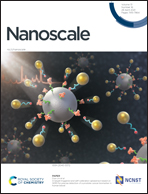Modulation of MoTe2/MoS2 van der Waals heterojunctions for multifunctional devices using N2O plasma with an opposite doping effect†
Abstract
van der Waals layered heterojunctions have a variety of band offsets that open up possibilities for a wide range of novel and multifunctional devices. However, due to their poor pristine carrier concentrations and limited band modulation methods, multifunctional p–n heterojunctions are very difficult to achieve. In this report, we developed a highly effective N2O plasma process to treat MoTe2/MoS2 heterojunctions. This allowed us to adjust the hole and electron concentrations in the two materials independently and simultaneously. More importantly, for the first time, we were able to create opposite doping on the two sides of the junction through a single-step treatment. With a very wide doping range from pristine to degenerate levels, a MoTe2/MoS2 heterojunction can be modulated to behave as a forward rectifying diode with enhanced rectifying ratio and as a tunneling transistor with negative differential resistance at room temperature. The new approach provides an effective and generic doping scheme for heterojunctions to construct versatile and multifunctional electronic devices.



 Please wait while we load your content...
Please wait while we load your content...